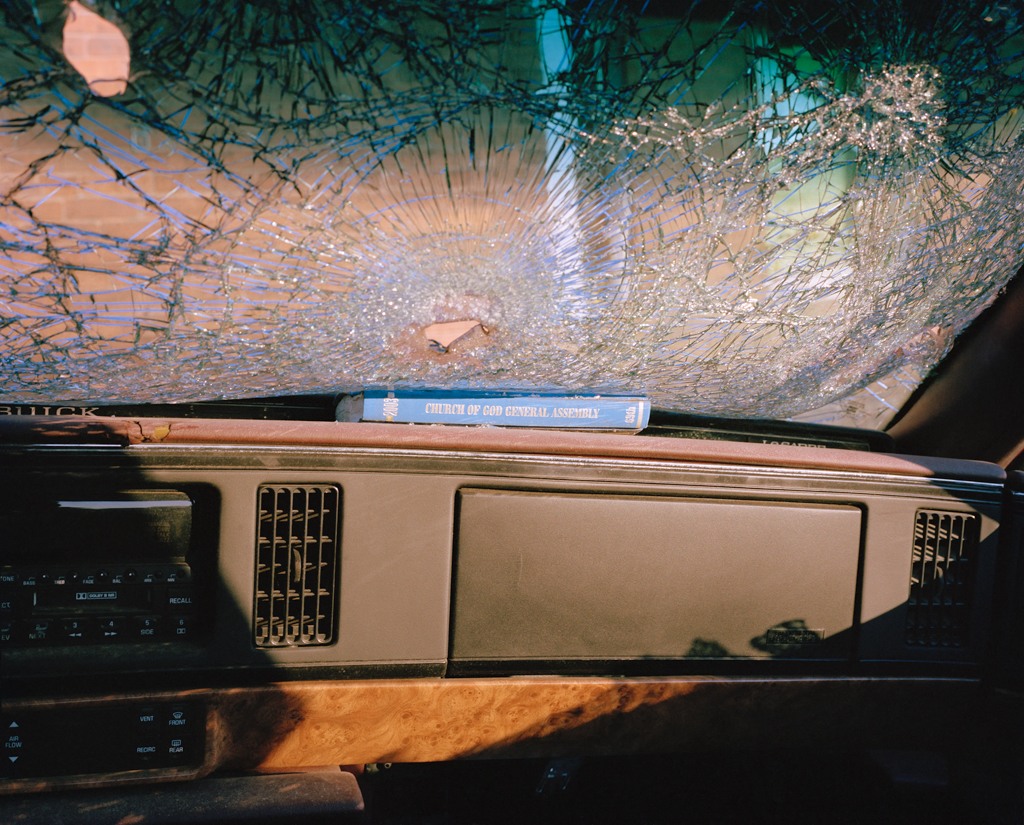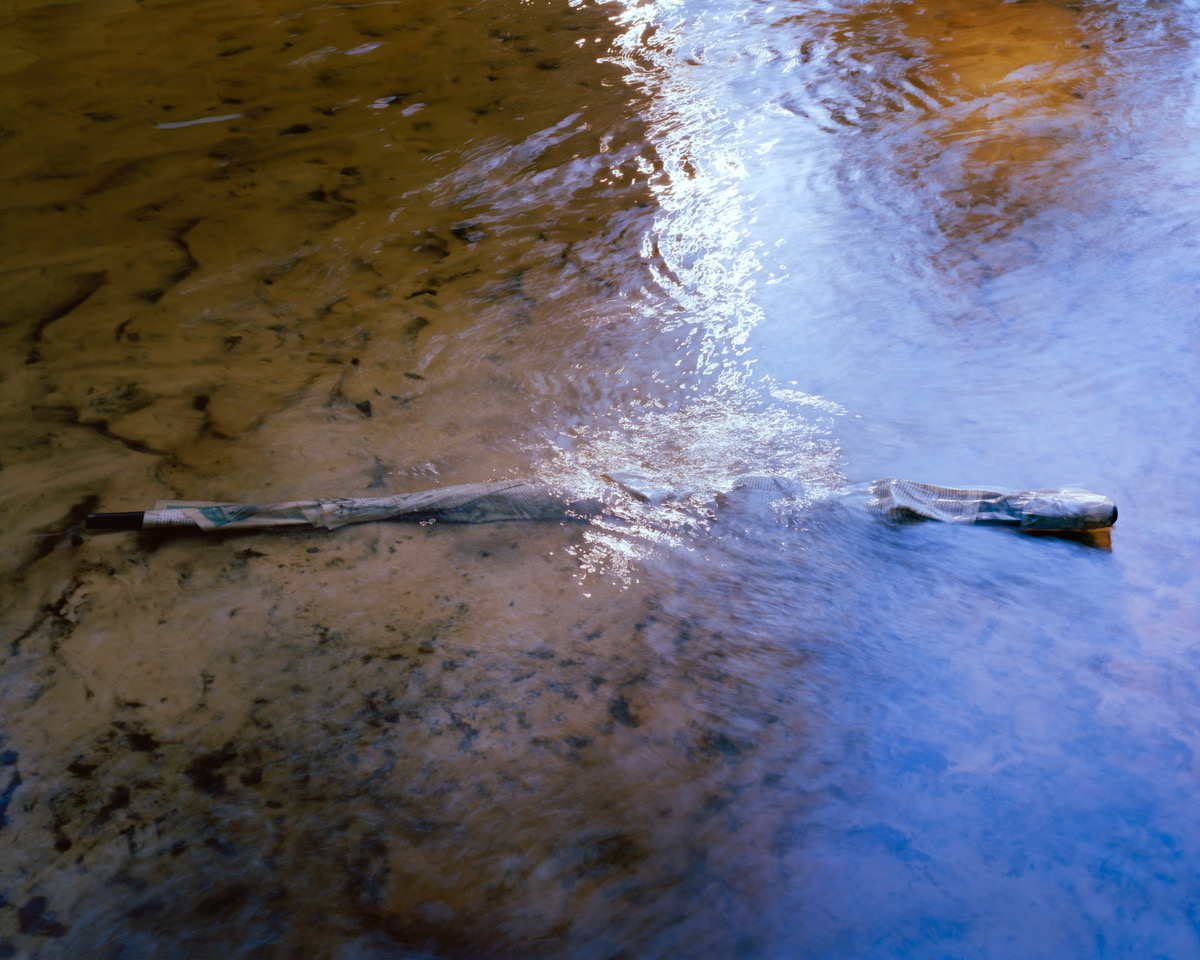Photography as Choreography: Confessions for a Son
February 7, 2020
Born and raised in Laurinburg, North Carolina, nationally acclaimed photographer McNair Evans bases much of his work in the rural South. In November 2019, Evans spoke with Duke undergraduates in Lou Brown’s Ethnojournalism class about his beginnings as a student of cultural anthropology and his career as a visual artist. The conversation centered around one of his most famous projects, Confessions for a Son.
By Cydney Livingston

McNair Evans, Company Car
Evans’ project was a quest to understand his late father, his family’s narrative, and himself following the death of his father.
When he discovered that the family business was millions of dollars in debt, Evans relied on the tool he most frequently turns to for understanding and insight: photography. Perhaps surprisingly for a project grounded in rural North Carolina, Evans began in his current home of San Francisco, looking for people who reminded him of his father. He captured an image of a man in a park, focusing in on the man’s hand. That hand, spread across a broad tree trunk, evoked thoughts not only of Evans’ father but also of other hard-working men of his father’s generation. “I can’t access the subject, my father, but I can directly access my experience of the subject,” Evans explained, describing how he approaches his work. He captures disconnected instances of a theme, and when he brings the pieces together, they provide glimpses into a larger topic and new ways of seeing ordinary occurrences.

McNair Evans, Dad's Hands
In one series of photos, he returned year after year to his father’s abandoned office building and equipment as it suffered vandalism, decay, and ultimately, destruction by fire. The resulting photos convey far more than the story of one man’s failed business; they call to mind a broader story of the ghosts that have come to occupy so many small southern towns. Similarly, Evans’ choice to photograph the backside of a man leaning against a farm trailer uses the man’s facelessness to transcend the particular moment, allowing the viewer to ponder the implications of the man’s posture and the setting. These photos exemplify Evans' talent for shining a fresh light on mundane objects, actions, and places.

McNair Evans, Midway Cotton Gin
Evans is deeply embedded in Confessions for a Son. For example, he chose to capture his father’s gun collection through portraits. One photograph depicts a gun wrapped in newspaper, floating on a river. The gun belonged to Evans’ father and had been passed down from his father before him. Evans says this is a common way for rural families to connect to their ancestors. Tossing the gun into the river signified his frustration with his family’s history and was a symbolic gesture of cleansing and healing.

McNair Evans, Papa’s Shotgun
In another photograph, Evans captured an all-night exposure of his childhood bedroom. This image exemplifies the artist’s acclaimed use of light and his acuity with visual storytelling. Because of the prolonged time exposure, the photo includes both the bright bluish shades of dawn and the yellowish tones of an exterior floodlight. While the light of dawn elicits a sense of the hope and excitement Evans felt as a child when he awakened in that bedroom, the floodlight represents the isolation and fear of his widowed mother. She lives alone in the house now and worries about potential intruders. “I do feel guilt in our relationship as her only son and not being there to take care of her,” Evans responded when questioned about the layers of feeling embedded in the photograph.

McNair Evans, Floodlight
Evans’ approach to photography is informed by his undergraduate training in cultural anthropology at Davidson College in North Carolina. In his senior year, he researched a sprawling family of 13 children and their often conflicting memories of shared family experiences. He documented their stories through interviews and photographs. This sparked Evans’ love for photography which he pursued post-graduation through an apprenticeship and, eventually, a Master of Fine Arts degree. Kaylin Woodward, a junior, found his story “liberating.” Through the Ethnojournalism class, Woodward, a political science major, has uncovered her own passion for storytelling for social change and was inspired to hear that Evans’ career path wasn’t settled when he graduated from college.
Evans produces choreographed works. He orchestrates photos after establishing relationships with his subjects, giving him the ability to capture images of vulnerable moments.
All of Evans’ work stems from his anthropological interpretation of the world. He studies the experiences of individuals to understand how those experiences happen and what larger phenomena they can speak to. In his advice to students, Evans said that a project should be like an hourglass: wide curiosities and concepts at the top brought into a tight focus around specific moments and stories in the middle, and then expanded back out in ways that allow insights into society’s larger structures.
When asked how he approaches people he wants to photograph, Evans emphasized, “You need to be able to explain what you are doing and why.” This is foundational to his broader goals of operating with transparency and building trust with people. Initially, when creating Confessions for a Son, Evans faced skepticism and criticism from family and close friends for asking sensitive questions about their experiences and history. Ultimately, though, he said that subjects “buy in” to projects in response to the integrity that you bring to it — an important factor given that every single photo is a collaboration between artist and subject. When his friends and family understood that he wanted to do more than simply tell his family’s story, that he also wanted to connect with more universal experiences, they bought into his vision.
Few of Evans’ photos are candid — shot without the awareness and preparation of the subject. To Sophomore Tyler Edwards, this didn’t come as a surprise. “I wouldn’t expect a great theatrical production to be the result of improv,” said Edwards, a biology major who is active in Duke’s theater community. Though the medium is different, Evans produces choreographed works. He orchestrates photos after establishing relationships with his subjects, giving him the ability to capture images of vulnerable moments. He reminded us that such access is a gift from his subjects that needs to be handled with care and respect. Students who had the opportunity to learn about McNair Evans’ work — myself included — left the discussion with much to ponder about the responsibilities and gifts we need to manage in our own work with other people’s stories.
 CYDNEY LIVINGSTON is a sophomore at Duke University from Wadesboro, North Carolina, majoring in History and Biology. As a student in Lou Brown’s Fall 2019 course, “Ethnojournalism,” taught at the Forum for Scholars and Publics, she researched and wrote about her dad’s job working with turkeys and turkey farmers. Her experience with that project — which turned into something much richer than she anticipated — deepened her interest in McNair Evans’ photographic exploration of his own father’s business, family, and friendships.
CYDNEY LIVINGSTON is a sophomore at Duke University from Wadesboro, North Carolina, majoring in History and Biology. As a student in Lou Brown’s Fall 2019 course, “Ethnojournalism,” taught at the Forum for Scholars and Publics, she researched and wrote about her dad’s job working with turkeys and turkey farmers. Her experience with that project — which turned into something much richer than she anticipated — deepened her interest in McNair Evans’ photographic exploration of his own father’s business, family, and friendships.
check us out
on social media